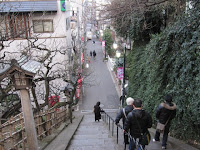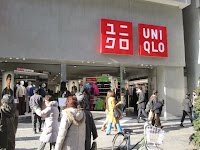

The northern and western parts from the Imperial Palace were the busiest commercial districts in Edo (former name of Tokyo) in the Edo era (early 17th century - mid 19th century). The areas turned to Ueno, Asakusa, Kanda, Nihonbashi and other small towns in current names.
 Yushima locates next to Ueno. There are temples and shrines including Yushima Shrine in the area.
Yushima locates next to Ueno. There are temples and shrines including Yushima Shrine in the area.
 Yushima locates next to Ueno. There are temples and shrines including Yushima Shrine in the area.
Yushima locates next to Ueno. There are temples and shrines including Yushima Shrine in the area. I visited Kyu-Iwasaki-tei-teien (Former Iwasaki family house garden). It was originally a private house of the Iwasaki family, the founder of the Mitsubishi group in the early Meiji period. It became open to the public after the World War 2.
There are the western and Japanese style houses in the garden. The western house was built in 1896 by a British architect Josiah Conder. They spent their daily lives in their Japanese house and used the western house when they welcomed their guests, according to a tour guide.
 Mori Ogai, one of the most famous novelists in the nation in the Meiji era, lived in the area and wrote “Maihime” (The Dancing Girl), one of his greatest works. The house has turned into a hotel. The old house remains and is used to dine their guests.
Mori Ogai, one of the most famous novelists in the nation in the Meiji era, lived in the area and wrote “Maihime” (The Dancing Girl), one of his greatest works. The house has turned into a hotel. The old house remains and is used to dine their guests.
 The Shinobazu Pond lies between Yushima and Ueno districts. There is a small shrine in a small island (which is connected with the land by a path) inside the pond.
The Shinobazu Pond lies between Yushima and Ueno districts. There is a small shrine in a small island (which is connected with the land by a path) inside the pond. I found several monuments. One monument was built to console the spirit of cooked globe fish. Others were for cooked birds, broken knives and broken glasses. They were so funny.
I found several monuments. One monument was built to console the spirit of cooked globe fish. Others were for cooked birds, broken knives and broken glasses. They were so funny. 



































